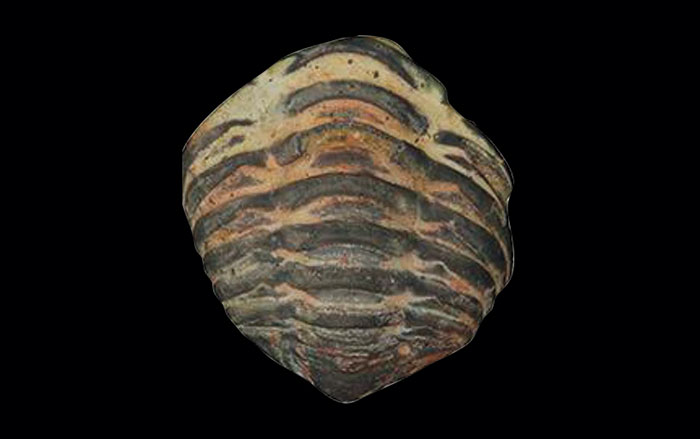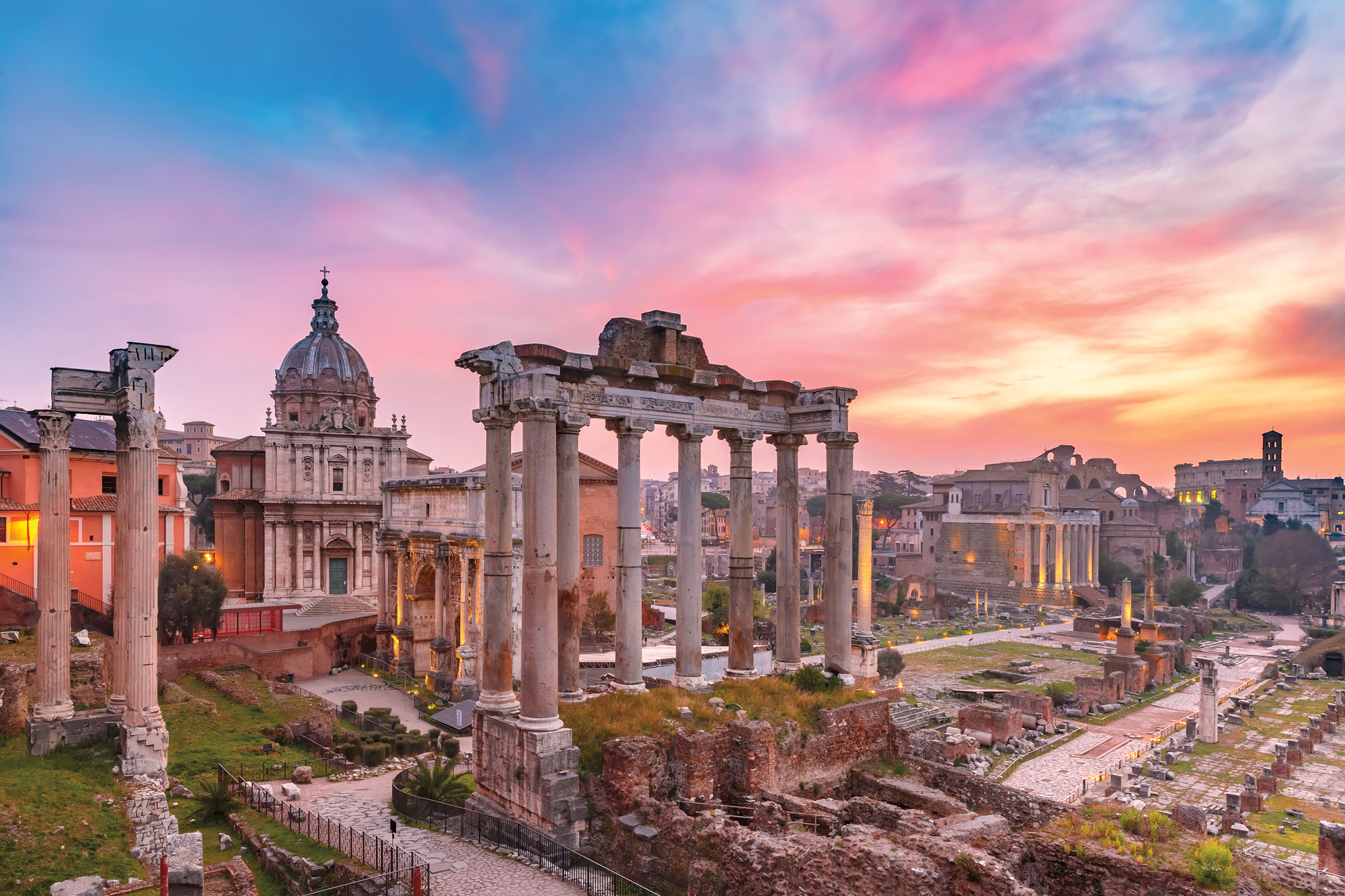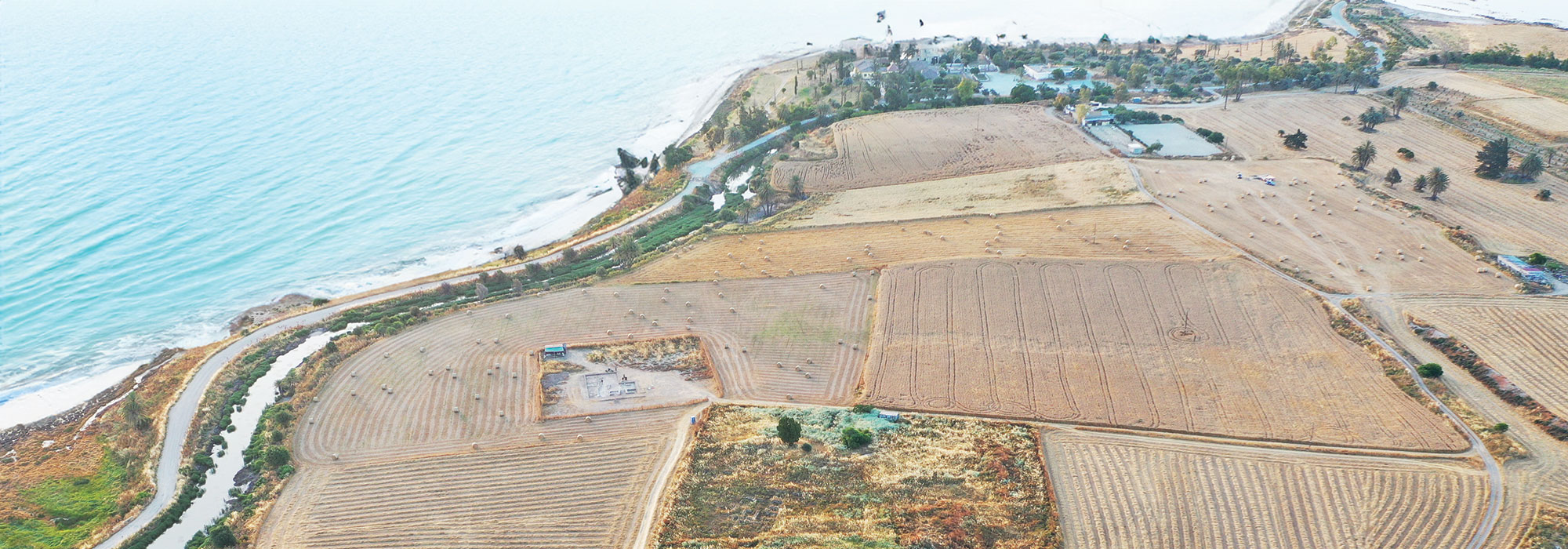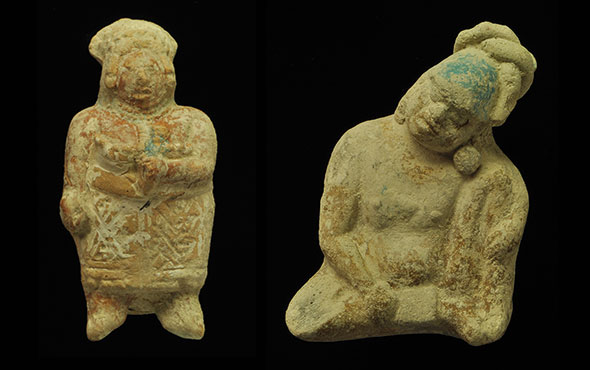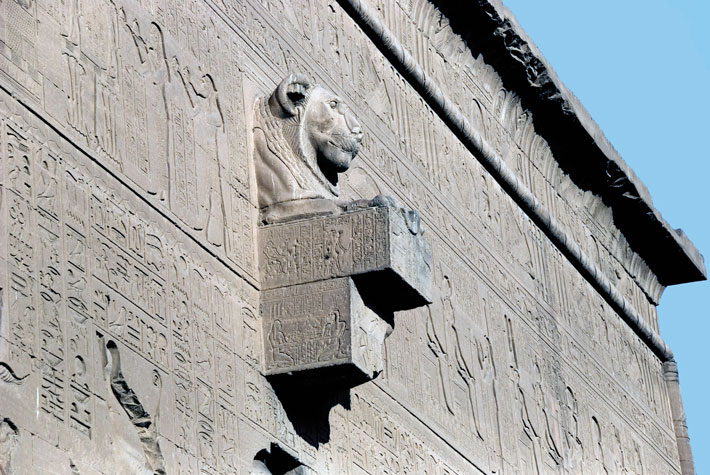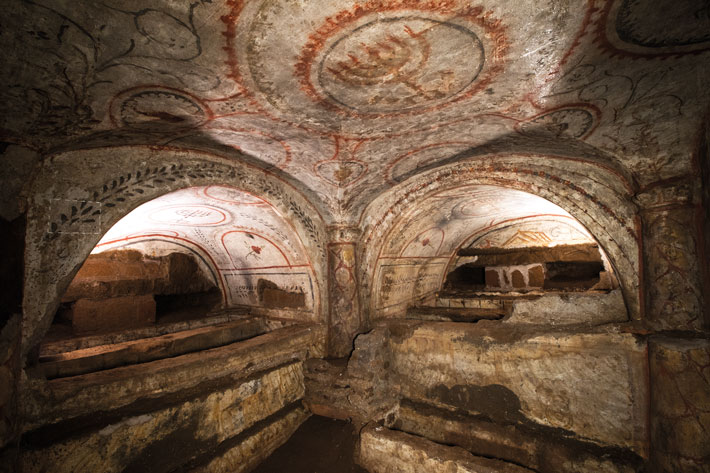
Giovanni Torlonia, an Italian noble who had followed his family into the banking business, began to renovate and upgrade his sprawling estate just beyond Rome’s Aurelian Walls on the Via Nomentana, an ancient road leading north out of the city, in 1919. Since Torlonia’s great-grandfather had acquired the land in 1796, the estate had become host to a combination of stunning architectural constructions and at times bizarre attempts to capture the wonders of the past. The centerpiece was the Casino Nobile, a white mansion that stood at the top of a grand staircase and featured a neoclassical portico with a triangular roof framing a terracotta bas-relief. In addition to a large ballroom lined with mirrors and lit by chandeliers, the mansion was decorated with hundreds of antiquities, including Greek and Roman statues and vases, some acquired from archaeological digs the family had funded during the nineteenth century. Disappointed that the estate itself had yielded no ruins, Giovanni’s grandfather, Alessandro, had commissioned a range of facsimiles to dot the landscape, including Egyptian obelisks, a basilica, a dilapidated Temple of Saturn, and a miniature Roman Forum with fallen columns. Giovanni carried on the tradition, installing an Etruscan-style tomb in the mansion’s basement. Many of these structures still stand on the estate, which is now a public park.
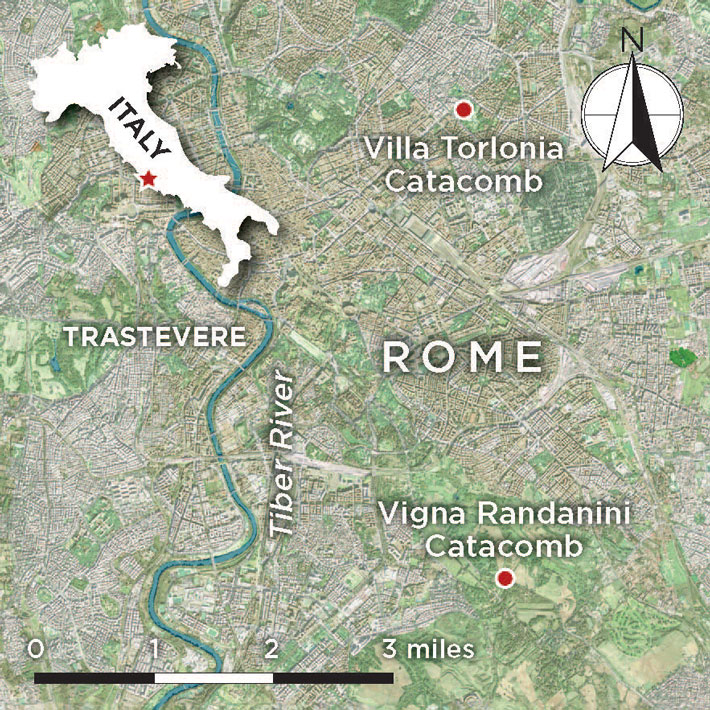
While digging to build a new stable as part of the 1919 renovations, workers discovered a catacomb, with mazes of passageways whose walls were filled with niches for the dead. From the second through fifth century A.D., catacombs were a common approach to burial in Rome. Rapidly advancing urban development in the early twentieth century led to the discovery of many ancient catacombs, while others had been unearthed as early as the Middle Ages. These underground necropolises emerged as popular targets for grave robbers, explorers, and, eventually, archaeologists. To date, more than 60 catacombs, amounting to hundreds of miles of passages, have been identified beneath the city.
But the catacomb at Villa Torlonia stands out, and has since its discovery. When archaeologists first entered the underground complex, they were struck by the numerous depictions of menorahs—candelabras with seven branches—on the wall and ceiling frescoes and grave markers. This was a clear sign that this catacomb was Jewish, unlike most of the others in the city. Villa Torlonia was the sixth, and so far the last, Jewish catacomb to be found in Rome and is one of just two accessible today. The other is Vigna Randanini, which was discovered in 1859 and is located on the Appian Way, a major ancient road that is home to several Christian catacombs as well. Three others also identified during the nineteenth century were later reburied and lost. The first Jewish catacomb to be discovered, in the early seventeenth century, was located in the Monteverde neighborhood. Scholars studied it and recorded many of its inscriptions, but it was buried by a landslide in the early twentieth century.
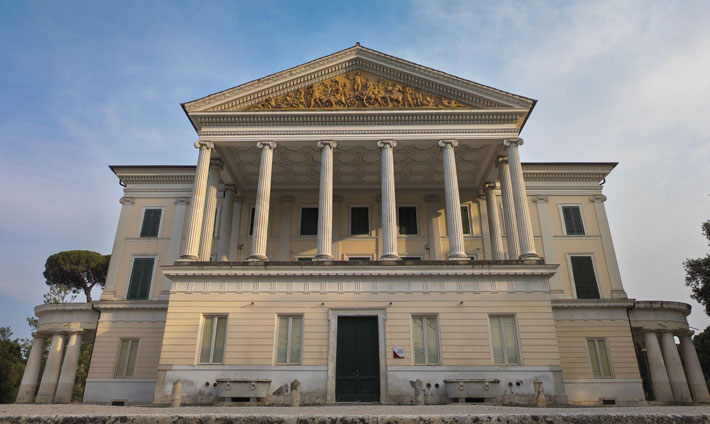
Around 600 inscriptions from Rome’s Jewish catacombs have been documented in all, making up the largest collection of archaeological evidence from any early European Jewish diaspora community. Shortly after the Villa Torlonia catacomb’s discovery, the American classicist Harry Leon, then a doctoral student at Harvard University, wrote: “Whether or not Rome will yield more Jewish catacombs and inscriptions, the material at present available is sufficient to permit a partial reconstruction of certain aspects of the ancient community.” Leon’s statement remains true, say modern scholars of the site. A recent restoration and survey project at Villa Torlonia, overseen by the Archaeological Superintendency of Rome, resulted in the discovery of additional burials, inscriptions, and artifacts. “The catacombs are virtually the only surviving testimonies of a distinctly Jewish material culture in ancient Rome,” says Jessica Dello Russo, an archaeologist at the Center for Israel Studies at Yeshiva University. “We wouldn’t know about these people without the evidence from the Jewish catacombs.”
Today, many of the buildings in Villa Torlonia Park serve as museums, theaters, and other cultural centers. A long hall with large, arched windows originally designed to mimic an orangery is now home to La Limonaia, an upscale restaurant serving local cuisine. Across the grounds via a network of walking trails is the Serra Moresca, the Moorish Greenhouse, built in an orientalist style with colorful stained-glass windows. The entrance to the catacomb is located near the western edge of the estate, between two former stables that are now part of the library of the National Academy of Sciences. A fenced-off staircase shaded by trees leads underground. The steps narrow as they approach the dark corridors, which are around three feet wide.
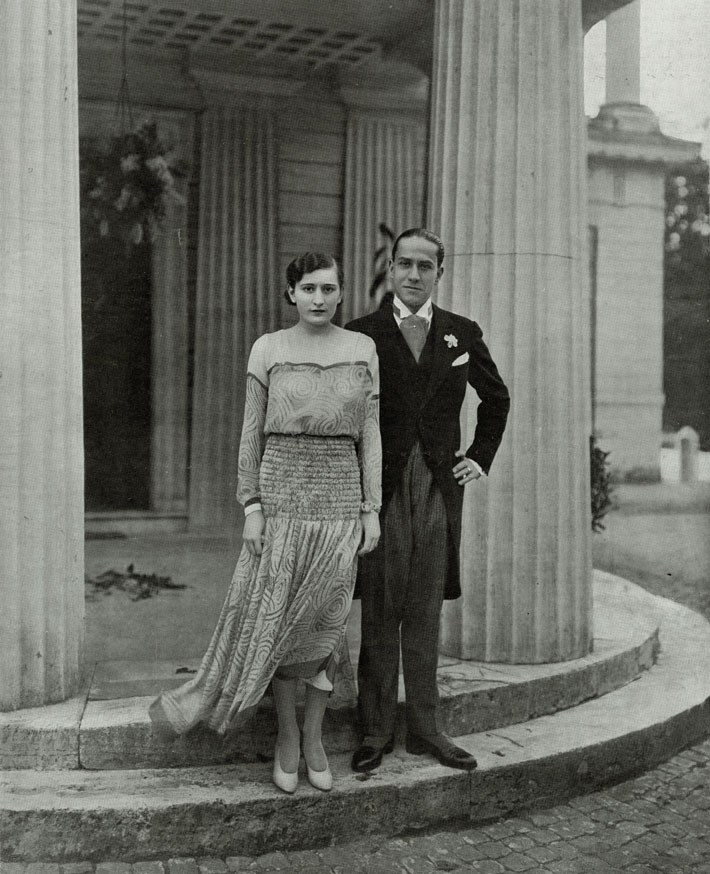
The catacomb’s passageways are lined with nearly 4,000 shelves carved into the walls to hold the dead. Many of the names of the deceased are still visible, generally painted on or carved into stucco used to seal the graves, along with blessings to rest in peace and other inscriptions. In a few places, the catacomb’s narrow passageways open into atriums where colorful frescoes decorate the vaulted ceilings and many of the arched recesses. In addition to menorahs, these frescoes feature Jewish motifs such as a holy ark to house Torah scrolls; shofars, ram’s-horn trumpets blown on religious holidays; and lulavs, palm branches waved during the festival of Sukkot, which celebrates the harvest season. There are also geometric designs and illustrations of peacocks, roosters, flowers, and fruit trees, possibly meant to depict paradise.
Studying the site has not been easy. Fear of collapse prevented Leon and others from continuing their exploration after just a few years. Then, in 1925, Torlonia offered the Fascist leader Benito Mussolini, who had recently forced Italy’s king out of power, use of the property as his official residence. Mussolini moved into the Casino Nobile with his family, where they would stay for the next 18 years, and made the estate off-limits to archaeologists. Torlonia himself relocated to the Casina delle Civette, the House of the Owls, perhaps the property’s oddest structure. It had originally been built as a Swiss chalet, but Torlonia made multiple additions in a hodgepodge of styles, many incorporating owl motifs. During Mussolini’s time at the luxurious estate, he played tennis, practiced horse jumping, honed his fencing skills, and hosted lavish events such as a breakfast following the wedding of his daughter Edda. In 1938, Mussolini announced restrictive measures against Jews, including banning them from teaching in public schools, marrying non-Jews, serving in the armed services, and working in particular sectors, such as journalism. Mussolini’s government was well aware that a Jewish catacomb dating back 1,800 years sat below his palatial residence and heavily guarded its entrances, fearing it could provide a route into the estate.

Allied troops occupied the property for several years after the end of World War II, and archaeologists didn’t return to the catacomb until the 1970s. Over the following two decades, various teams carried out surveys and work to stabilize the site, noting new findings, such as several shafts that had been designed to let in fresh air, more inscriptions, and additional evidence of the complex’s date. When the Torlonia property became a city park, control over its catacomb passed from the Vatican, which had overseen all of Rome’s catacombs, to the Italian government.
Beginning in 2018, the team from the Archaeological Superintendency of Rome thoroughly surveyed the catacomb, repaired leaks that were damaging frescoes, shored up the passageways, and collaborated with a religious conservation project. Under rabbinic guidance and out of respect for the significance the site holds for the religious and cultural identity of the Jewish people, conservators used a clay mixture similar to the original to seal off more than 3,000 graves that had been broken open over the years. They also collected scattered skeletal remains found in the catacomb’s passageways and buried them in a common grave. Although researchers aren’t able to study the bones of the dead, the Villa Torlonia catacomb continues to offer valuable historical insight into the people who made up Rome’s early Jewish community.
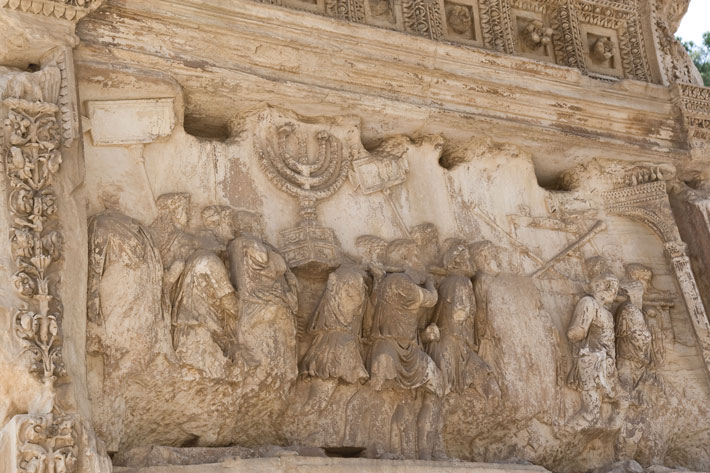
Jews first came to Rome in the second century B.C., some as slaves captured in wars, and some as immigrants. This makes Rome one of the two earliest destinations of the Jewish diaspora in Europe; Jews arrived in Greece around the same time, or possibly about a century earlier. “Rome was seen as a place that was stable, where you could build a community,” says historian Samuele Rocca of Ariel University. Jews attended public assemblies and took part in Roman politics, according to the first-century B.C. writer Cicero, though he took a negative view of their participation. First under Julius Caesar and then under the emperor Augustus (reigned 27 B.C.–A.D. 14), who greatly expanded the empire, Rome’s Jewish communities were considered legal entities, with jurisdiction over matters such as marriage, divorce, and civil disputes between Jews. A number of synagogues were built, including one dating to the first century A.D. in Ostia, which was then Rome’s main port. At this point, Rome’s Jewish community may have numbered 40,000 to 50,000, around 5 percent of the city’s total population.
Official Roman propaganda at times targeted Jews. This was especially the case during the First Jewish-Roman War (A.D. 66–73), in which Jewish forces in the ancient province of Judea rose up in revolt against the Romans, who had enacted punitive tax policies and, the Jews believed, stolen money from the Temple, the center of Jewish religious practice in Jerusalem. During the war, in A.D. 70, the Romans destroyed the Temple. Their commander, Titus, would later become emperor (reigned A.D. 79–81). As was common to mark military victories, the Romans built a triumphal arch celebrating Titus’ exploits that depicts Roman soldiers marching off with the Temple’s seven-branched menorah and other sacred objects. The arch still stands in the Roman Forum. Nonetheless, Rocca says, life remained stable for Rome’s growing Jewish community. Many of the enslaved captives brought back from Jerusalem were sold in the countryside and never made it to Rome. Ultimately, some of these enslaved Jews were able to win their freedom, and a few went on to become Jewish community leaders. In A.D. 212, the emperor Caracalla (reigned A.D. 198–217) declared that any free male living in Roman territory could become a citizen.

By the late second century A.D., the catacomb at Villa Torlonia had come into use. The cross vaults and arches found in it are also seen at other sites from that time in Rome, says archaeologist Yuval Baruch of the Israel Antiquities Authority, who recently carried out a photogrammetric study of the complex. However, radiocarbon dating of charcoal fragments embedded in lime used to seal some of the graves that was carried out by archaeologist Leonard Rutgers of Utrecht University suggests the catacombs were used at least 100 years earlier, beginning in the first century A.D. “This opens up the possibility that the whole idea of catacombs originated with the Jewish community,” he says. The standard funerary practice among pre-Christian Romans was cremation, which was incompatible with Jewish tradition. Underground burials had a precedent in Jewish history and likely offered an appealing alternative to Rome’s Jews. “It’s possible that they brought the tradition with them when they came to Rome,” Rutgers says. He notes that the shape of some tombs in the Jewish catacombs, especially in Vigna Randanini, with openings for the bodies extending into rather than along the walls, could have been modeled on similar kohkim tombs common among Jews in the Eastern Mediterranean, including Jerusalem. But not all scholars are convinced that Jews pioneered the use of catacombs in Rome. According to Dello Russo, the evidence strongly suggests that Christians, Jews, and others all began using catacombs only in the second or third century A.D. She also points out that other non-Jewish groups carried out underground burials elsewhere in Italy long before Rome’s catacombs came into existence.
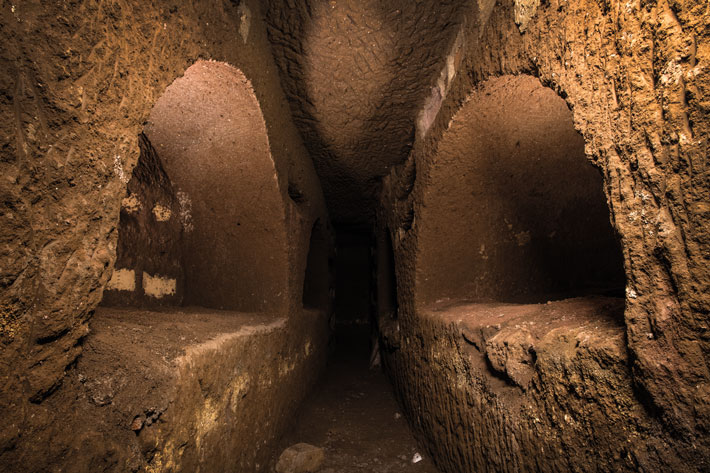
The Villa Torlonia necropolis started out as two separate underground burial complexes that were eventually joined. The deeper complex, which reaches around 30 feet underground, may have originally been dug as part of Rome’s water system, a pattern seen in other catacombs in the city. This section of the catacomb includes an open area at the foot of the entry stairs, probably meant to receive the funeral bier along with mourners, says Marzia Di Mento, an archaeologist working with the Archaeological Superintendency of Rome who was involved in the recent survey. This funerary arrangement is described in the Mishnah, the earliest written collection of Jewish laws and traditions, compiled in the late second century A.D. Beyond this open area are several passageways lined with simple burial niches. During the recent survey, archaeologists found a wall carving along one of the corridors depicting part of the catacomb’s layout. Archaeologists say this could be a plan meant for builders to follow. “This carving can be read as evidence of how the niches in this area were constructed,” Di Mento says.
The upper part of the catacomb, which extends to about 16 feet deep, includes larger burial spaces framed by recessed arches decorated with elaborate frescoes. Di Mento says the two distinct areas likely represent older and newer sections, with the deeper one built first. Baruch, on the other hand, believes the sections could have been used or built by people from different communities or social classes. With its more ornate and commodious design, the upper section may have been used for burial of wealthier members of the community. This section also contains most of the catacomb’s illustrations. The recent survey revealed around 50 additional burials under the floors of the catacomb’s corridors, throughout both parts of the complex. “This means the catacomb was likely used over a long period of time,” Di Mento says. “Once all the wall space was used, they began using the floor space as well.”
Based on the hundreds of inscriptions found at Villa Torlonia and the other Jewish catacombs in Rome, it seems that Rome’s Jews were integrated into the city, working in professions ranging from butchery to medicine, and worshipping in at least 11 different synagogues throughout the city. Membership in these congregations is believed to have been based on where worshippers lived and where they came from. About 75 percent of the inscriptions in the Villa Torlonia catacomb are written in Greek, the language spoken in the eastern parts of the empire, including cities in Egypt, Greece, and Judea, where many of Rome’s Jewish communities had their roots. The rest of the inscriptions are mainly in Latin, and many of the Greek inscriptions include Latin names written in Greek letters. “This shows a movement toward Latin, which was the more dominant language in Rome,” Rutgers says. “But the use of both of these languages shows a high level of cultural integration.” Only one inscription in Hebrew has been found. It was partly deciphered during the recent work and it, too, appears to contain a Latin name—Clodio—followed by the words “shalom, shalom.” Di Mento says it is likely part of a eulogy meaning something akin to “rest in peace.”

Rome’s six known Jewish catacombs were located in various parts of the city’s outskirts, suggesting that the Jewish community was not concentrated in one place. “In general, we know that people were buried near where they lived,” Rutgers says, adding that Roman law forbade burials within the city; thus they were often located along main roads leading out of town. “We also see that the inscriptions place a lot of emphasis on the person’s role in the Jewish community. This is their prime identifier and what is important to them.” Inscriptions tend to include the name of the deceased’s synagogue as well as the position they held in it, such as rabbi, community board member, or benefactor. However, many graves lack inscriptions, pointing to large numbers of Jews who were poor.
Throughout the Villa Torlonia catacomb, menorahs are depicted both in decorative frescoes and alongside simple tomb inscriptions. The prevalence of images of menorahs is unique for the time. Even in Jerusalem, just a few depictions of menorahs are known from before the destruction of the Temple in A.D. 70. “It was at Villa Torlonia that the menorah, which was later commonly used in Jewish art and in synagogues, began to emerge as a major Jewish symbol, and also to take on eschatological meanings,” Baruch says. He explains that the menorah was originally a symbol associated with the priests of the Temple in Jerusalem. After the Temple’s destruction, the menorah came to be connected to the belief that the Temple would be rebuilt, ushering in the coming of the messiah and resurrection of the dead. “This was a community that developed under the shadow of the Arch of Titus,” says Baruch. “They were constantly reminded of the Temple’s destruction, and the menorah was a symbol of that. At the same time, there was hope for the rebuilding of the Temple, and the menorah was also a symbol of that.”
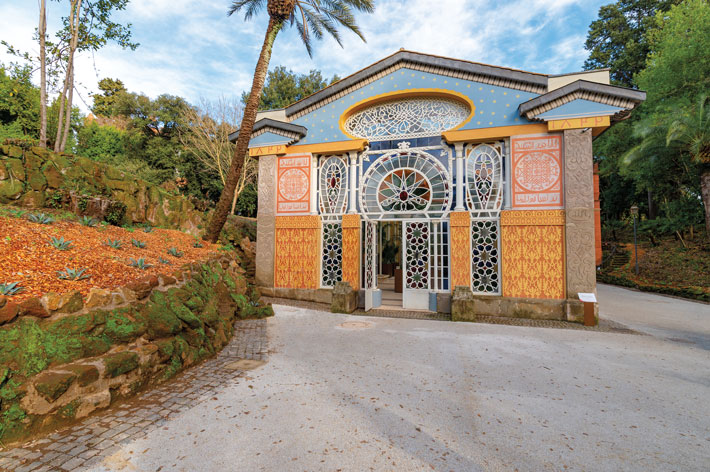
The use of catacombs, at Villa Torlonia and elsewhere, appears to have come to an end at the beginning of the fifth century A.D. This coincided with the decline of Rome, when the city’s population shrank significantly in the wake of numerous nomadic invasions and outbreaks of disease. The standing of Jews in Rome had also diminished significantly by then. Following the empire’s embrace of Christianity under the emperor Constantine (reigned A.D. 306–337) in A.D. 312, and the declaration of Christianity as the empire’s official religion by the emperor Theodosius I (reigned A.D. 379–395) in A.D. 380, marriages between Jews and Christians were banned, Jews were forbidden from owning Christian slaves, and Christians who converted to Judaism could have their property confiscated. “We cannot really know what happened to the Jews,” Rocca says. “Most probably left.”
Centuries after Rome’s catacombs had ceased to be used, interest in them began to grow, mainly among Christians. Pilgrims visited the underground burial sites and left behind signatures and other graffiti on walls. The existence of Jewish catacombs was virtually unknown, although there were occasional hints. In 1160, Spanish Jewish traveler Benjamin of Tudela reported seeing caverns containing Jewish burials on a hillside above the Jewish ghetto, known as Trastevere, on the western bank of the Tiber River. A thirteenth-century document connected to the ownership of the land that would become Villa Torlonia also mentions the possible presence of a Jewish cemetery.
In 1602, Antonio Bosio, the author of the first extensive book about Rome’s catacombs, Roma Sotterranea, discovered a Jewish catacomb in a vineyard in the Monteverde neighborhood. It was near where Tudela had mentioned seeing a burial place. During the nineteenth century, four more Jewish catacombs were uncovered, including Vigna Randanini. Throughout most of this period, the Jews of Rome were confined to the Trastevere ghetto, where they lived in poor and unsanitary conditions. “They were intellectually and economically cut off from the rest of Roman life, and would not have been aware of these findings,” Rocca says. The Jews were only freed from the ghetto in 1870 with the unification of Italy following the fall of the Papal States, territories that had been ruled by the Pope for more than a millennium. All the while, hidden beneath Villa Torlonia and its array of fake antiquities was an authentic burial ground of some of these people’s early Roman forebears, waiting to reveal its secrets.



